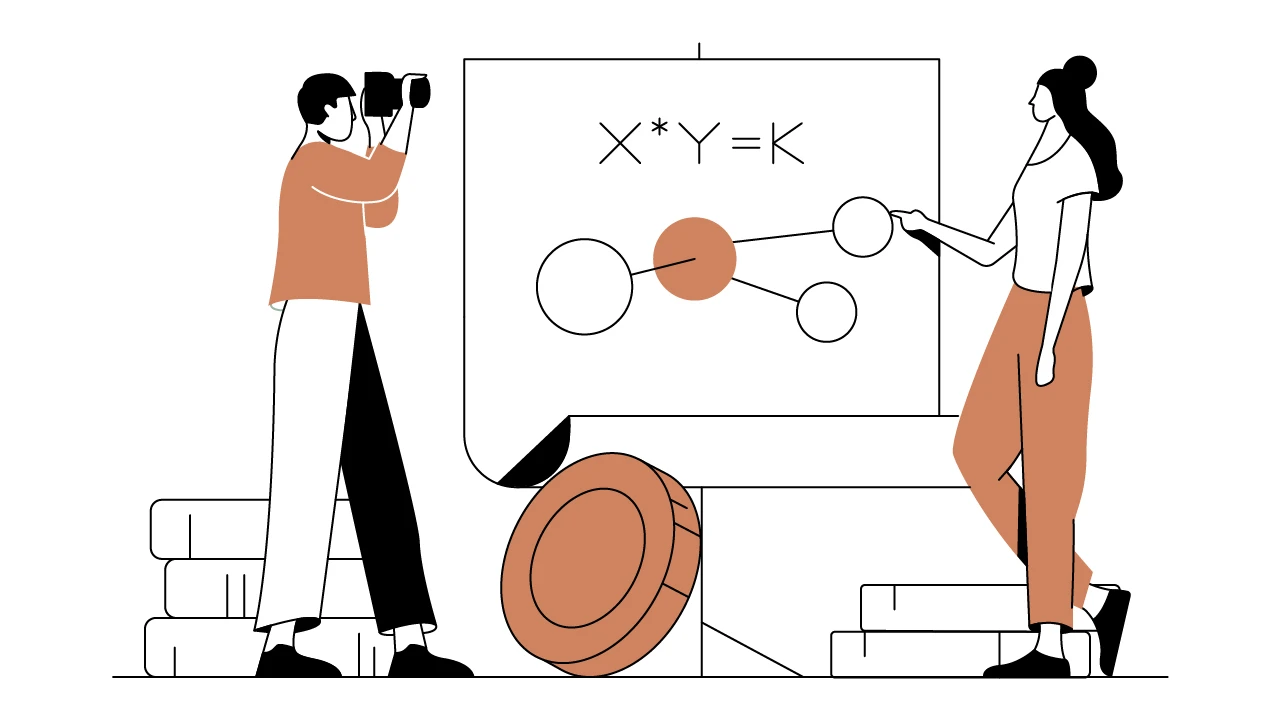Contents
What Is A Decentralized Exchange?
The Uniswap Crypto Dex and Its UNI Token
The SushiSwap Crypto Dex and Its SUSHI Token
The PancakeSwap Crypto Dex and Its CAKE Token
The Bancor Crypto Dex and Its BNT Token
The Curve Crypto DEX and Its CRV Token
The Balancer Crypto DEX and Its BAL Token
The 1inch Crypto Dex and Its 1INCH Token
The Growth State of Decentralized Exchanges
Exploring Popular Decentralized Exchanges
Decentralized exchanges are designed to enable peer-to-peer crypto trading — a major backbone of DeFi.
Updated December 21, 2021 • 6 min read

Summary
Decentralized exchanges (DEXs) aim to reduce or altogether eliminate the role of intermediaries in the trading of cryptocurrencies, instead relying on automated smart contracts to execute trades in a system of peer-to-peer (P2P) trading. Once a niche offering, today there are all kinds of DEXs catering to different types of users and built on a wide variety of blockchain ecosystems. Platforms can feature a broad range of infrastructural implementations and system architecture. Many crypto DEXs offer innovations in order books, liquidity pools, or other decentralized finance (DeFi) mechanisms like aggregation tools for novel and experimental financial instruments. Here we take a look at some of the most popular DEXs and what makes each of them unique.
What Is A Decentralized Exchange?
A decentralized exchange (DEX) is a peer-to-peer (P2P) cryptocurrency marketplace that connects buyers and sellers. In contrast to centralized exchanges (CEXs) — which retain custody of user funds held on the platform — decentralized platforms are generally non-custodial, meaning a user remains in control of their private keys and assets when transacting on a crypto DEX platform. In the absence of a central authority, DEXs employ smart contracts that self-execute under set conditions and record each transaction to the blockchain. These trustless, secure transactions represent an accelerating segment of the digital asset market, and are pioneering new financial products to enhance market making and liquidity.
Popular DEXs generally offer a wider array of digital assets than their centralized counterparts. In some cases, trading pairs can be established without any centralized oversight or permission. DEXs tend to have lower fees and more accessibility to a wider range of assets, but these advantages are sometimes provided at the expense of liquidity, security, and usability. That said, decentralized crypto exchanges continue to make strides toward refining the user experience and developing scalable infrastructure. Below is a decentralized exchange list covering some of the most popular DEXs in the crypto space today and exploring how they each cater to their own user base of crypto traders and investors.
The Uniswap Crypto Dex and Its UNI Token
Uniswap is one of the largest decentralized exchanges by volume, and a pioneer within the decentralized finance (DeFi) sector. The Uniswap platform is an Ethereum-based blockchain protocol that uses automated market makers (AMMs) and liquidity pools to facilitate peer-to-peer trading. An AMM is a smart contract that manages the Uniswap pools for which users provide the tokens that are used to trade. When a trade is made, Uniswap’s AMM algorithm helps determine an effective price for the token based on the supply and demand dynamics between the involved tokens in these liquidity pools. The system relies on liquidity providers (LPs) supplying tokens to Uniswap pools, who are then rewarded with a fee proportional to their share of the pool for every transaction.
In September 2020, Uniswap introduced UNI, a native governance token that facilitates greater community involvement and oversight. UNI token holders can vote on Uniswap project developments that determine the platform's evolutionary trajectory. Additionally, UNI token holders can use the token to fund liquidity mining pools, grants, partnerships, and other growth-driven initiatives that are designed to expand Uniswap's usability and reach.
The SushiSwap Crypto Dex and Its SUSHI Token
Created by the pseudonymous Chef Nomi, SushiSwap is a source-code fork of Uniswap that implemented notable community-oriented features such as staking rewards and a governance via its SUSHI token. SushiSwap is essentially a clone of its predecessor, Uniswap, but designed to give more control to its community of users. The birth of SushiSwap underscores the “decentralized” aspect of DeFi, as it shows how the DeFi community can dynamically adapt and pursue an activist agenda, redirecting its activity to competitors that offer more agreeable economic incentives and more inclusive governance.
This lesson was not lost on Uniswap, which eventually released its own governance token, UNI, and implemented similar community-centric features to regain some of the transaction volume it initially lost to SushiSwap. SushiSwap continues to see major growth alongside its counterpart, with both platforms serving as two of the most popular DEXs available to DeFi traders.
The PancakeSwap Crypto Dex and Its CAKE Token
Launched in September 2020, PancakeSwap is the first and hitherto largest crypto DEX protocol built on Binance Smart Chain (BSC). The popular AMM-powered DEX facilitates token exchanges, staking, and yield farming. In exchange for staking tokens in protocol liquidity pools, users receive LP tokens that they can farm to earn rewards in the form of the platform’s native utility and governance token, CAKE. The platform has recently introduced a non-fungible token (NFT) marketplace, lottery system, prediction market, and Initial Farm Offering (IFO) functionality.
Additionally, while BSC utilizes the BEP-20 token standard built for use on Binance Smart Chain, PancakeSwap prioritizes interoperability by supporting wrapped token deposits. As a result, a liquidity pool can include digital assets like ether (ETH) and bitcoin (BTC) alongside BNB and BUSD. However, in contrast to AMMs like Uniswap, PancakeSwap leverages the Centralized Decentralized Finance (CeDeFi) infrastructure that underpins BSC — designed so that users can experience consistent, low-cost transactions. In short, CeDeFi is exemplified by platforms that integrate both centralized and decentralized architecture to improve the user experience.
The Bancor Crypto Dex and Its BNT Token
Bancor deployed some of the first-ever AMMs on Ethereum in 2017, before “DeFi” had been coined in respect to the nascent sector. As an original pioneer of AMMs, Bancor has had plenty of time to develop innovations in the space. The protocol’s latest version, Bancor v2.1, offers several key features to liquidity providers, including single-sided exposure and impermanent loss (IL) protection.
A user may provide liquidity to a Bancor pool with a single token and maintain 100% exposure to the token. In contrast, many other AMMs require liquidity providers to take on exposure to multiple assets by providing liquidity to both sides of a liquidity pool. Further, Bancor v2.1 removes impermanent loss risk for liquidity providers and transfers it to the Bancor exchange protocol, which aggregates and backstops IL risk across its pools. The Bancor protocol uses fees earned from its co-investments of BNT tokens in pools to compensate for the network-wide cost of impermanent loss. While some pools may have high IL and low fees, others may have low IL and high fees. If there aren’t enough fees to fully compensate a liquidity provider's impermanent loss at the time of their withdrawal, the protocol mints BNT, Bancor’s native utility token, to cover the delta.
The Curve Crypto DEX and Its CRV Token
Curve is a popular AMM platform that offers a highly efficient way to exchange tokens while maintaining low fees and low slippage by only accommodating liquidity pools made up of similarly behaving assets like stablecoins, or wrapped versions of like assets such as wBTC and tBTC. This approach allows Curve to use more efficient algorithms, feature the lowest levels of fees, slippage, and impermanent loss of any DEX on Ethereum. Compared to other AMM platforms, the Curve model is particularly conservative in that it avoids volatility and speculation in favor of stability — thus providing an essential pillar for a deep and antifragile asset market.
In August 2020, the Curve protocol started its journey toward decentralized governance by launching a decentralized autonomous organization (DAO) to manage changes to the protocol. Most DAOs are controlled by governance tokens that give voting rights to holders of the tokens. In this case, the Curve DAO is controlled by the CRV token. The CRV token can be bought as well as earned through yield farming, which refers to the practice of depositing assets into a liquidity pool and earning tokens as a reward.
The Balancer Crypto DEX and Its BAL Token
Balancer is an AMM that allows users to create liquidity pools with up to eight different tokens in any ratio, acting as weighted index funds for the DeFi ecosystem. Instead of manually rebalancing liquidity pools like a traditional index fund, Balancer uses its constant mean market maker equation to automatically rebalance assets within pools via algorithm every time a trade is made. And instead of paying fees to a fund manager like an index, Balancer crypto DEX trading fees are paid directly to liquidity providers, who can also receive multi-purpose Balancer (BAL) tokens on a weekly basis.
The Balancer protocol is governed by the BAL token, which can be earned via liquidity mining by depositing cryptocurrencies into Balancer’s liquidity pools. The more liquidity, tokens, and value you provide to a Balancer pool, the more Balancer tokens you earn.
The 1inch Crypto Dex and Its 1INCH Token
1inch is an exchange aggregator that scans DEXs to find some of the lowest cryptocurrency prices for traders and help reduce slippage. Slippage occurs when insufficient trading volume results in purchasing an asset for more than was originally intended or the selling of an asset for less than was originally intended. The 1inch protocol aggregates liquidity across DEX platforms to deepen crypto DEX liquidity, which counteracts order slippage. In November of 2020, 1inch launched v2 of its protocol, enabling swaps across 21 popular DEXs. In addition to counteracting slippage on individual trades, the protocol also indirectly buffers price volatility across the broader DEX ecosystem by increasing liquidity across the broader market.
Users can benefit from providing tokens as liquidity on the 1inch DEX in order to earn 1INCH tokens, the platform’s native utility and governance token, as interest. While DAOs are relatively common in the cryptocurrency industry and in DeFi in particular, the 1inch DEX employs a governance model known as "instant governance." This proprietary model is designed to make it easier for token holders to modify the protocol. The 1inch Foundation asserts that instant governance offers holders more ownership of the platform by allowing everyone to participate in the governance process — claiming that every vote counts and that they avoid providing undue advantages to select token holders.
The Growth State of Decentralized Exchanges
In October 2021, DEXs processed nearly $90 billion USD in trading volume, with the combined volume of Uniswap and SushiSwap being responsible for over 80% of that amount. Despite the dominance of these two major DEX platforms, it’s important to understand that every DEX protocol integrates AMMs differently, catering to different types of users.
As the crypto DEX market matures, the proliferation of new protocols and supporting mechanisms will likely only accelerate. And while the lion’s share of DeFi activity is still taking place on the Ethereum network, the development of DeFi infrastructure — including DEXs — will continue and expand to other blockchain platforms as well. All this is a sign of the continuous growth and maturation of the DeFi industry.
Cryptopedia does not guarantee the reliability of the Site content and shall not be held liable for any errors, omissions, or inaccuracies. The opinions and views expressed in any Cryptopedia article are solely those of the author(s) and do not reflect the opinions of Gemini or its management. The information provided on the Site is for informational purposes only, and it does not constitute an endorsement of any of the products and services discussed or investment, financial, or trading advice. A qualified professional should be consulted prior to making financial decisions. Please visit our Cryptopedia Site Policy to learn more.

Is this article helpful?


